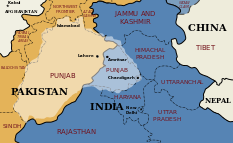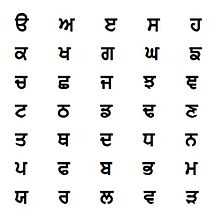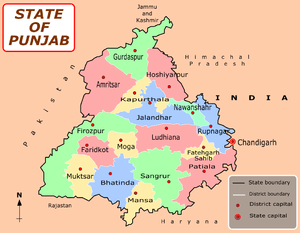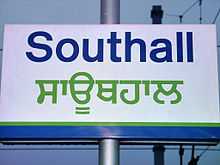Punjabi language
| Punjabi | |
|---|---|
| Panjabi | |
| ਪੰਜਾਬੀ • پنجابی • ⠏⠄⠚⠜⠃⠔ | |
 The word Punjabi in Gurmukhi and Shahmukhi (Nastaliq style) | |
| Native to | Pakistan, India |
| Region | Western Punjab, Eastern Punjab |
| Ethnicity | Punjabis |
Native speakers | 100 million (2010)[1] |
|
Indo-European
| |
|
Gurmukhi (Brahmic) Shahmukhi (Extended Perso-Arabic) Punjabi Braille (in India) | |
| Official status | |
Official language in |
North Parts of Rajasthan |
| Language codes | |
| ISO 639-1 | pa |
| ISO 639-2 | pan |
| ISO 639-3 |
Either: pan – Indian Punjabi pnb – Pakistani Punjabi |
 Distribution of native Punjabi and Lahnda speakers in Pakistan and India | |

Punjabi /pʌnˈdʒɑːbi/[3] (Gurmukhi: ਪੰਜਾਬੀ Paṃjābī; Shahmukhi: پنجابی Paṉjābī) is an Indo-Aryan language spoken by 130 million native speakers worldwide, making it the 9th most widely spoken language (2013) [1][4] in the world. It is the native language of the Punjabi people who inhabit the historical Punjab region of Pakistan and India. It is the only tonal language among the Indo-Aryan languages.[5][6][7][8]
Punjabi is the most widely spoken language in Pakistan[9] and the 11th most widely spoken in India[10] and the 3rd-most natively spoken language in Indian Subcontinent. Punjabi is the fourth most spoken language in England and Wales[11] and third most spoken in Canada.[12][13] The language also has a significant presence in the United Arab Emirates, United States of America, Saudi Arabia, and Australia. The influence of Punjabi as a cultural language in the Indian Subcontinent is increasing day by day due to Bollywood. Most Bollywood movies now have Punjabi vocabulary mixed in, along with a few songs fully sung in Punjabi. At any point in time, Punjabi songs in Bollywood movies now account for more than 50% of the top of the charts listings.[14][15][16]
Dialects and related languages
The major dialects of Punjabi include Majhi, Doabi, Malwai, Powadhi, Pothohari, and Multani. The dialects in the Lahnda dialect continuum, including Saraiki and Hindko, are considered as dialects of Punjabi by many linguists but as distinct languages by others.[17]
In Indo-Aryan dialectology generally, the presence of transitional dialects creates problems in assigning some dialects to one or another "language".[18][19] However, over the last century there has usually been little disagreement when it comes to defining the core region of the Punjabi language. The British linguist George Abraham Grierson came to the conclusion that a group of dialects known collectively as "western Punjabi" spoken north and west of the Punjab heartland, in the Indus valley itself and on the lower reaches of the other four tributaries (excluding the Beas River), in fact constituted a language distinct from Punjabi. He christened this group of dialects "Lahnda" in a volume of the Language Survey of India (LSI) published in 1919.[20] He grouped as "southern Lahnda" the dialects that are now recognized as Saraiki. In the National Census of Pakistan (1981) Saraiki and Hindko (previously categorized as "Western Punjabi"), got the status of separate languages,[21] which explains the decrease of the percentage of Punjabi speakers.
Standard dialect
The Majhi is Punjabi's prestige dialect because it is the standard of written Punjabi. It is spoken in the heart of Punjab in the historical region of Majha, which spans Lahore, Sheikhupura, Kasur, Okara, Nankana Sahib, Faisalabad (or Lyallpur), Gujranwala, Wazirabad, Sialkot, Narowal, Gujrat, Pakpattan, Hafizabad, Mandi Bahauddin Districts of Pakistan Punjab Province and also in major cities of Pakistani Punjab. In India it is spoken in Amritsar, Tarn Taran Sahib and Gurdaspur Districts of the State of Punjab and by a sizeable population in major cities of the State of Punjab and parts outside of the State of Punjab, such as in Dehli, Haryana, Uttaranchal, & North parts of Rajasthan. The Majhi (and Lahnda) spoken in Pakistan is more Persianized in vocabulary, and the usage of the letters Z, Kh and Gh are more profound.
| English | Gurmukhi based (Indian) | Shahmukhi based (Pakistan) |
|---|---|---|
| Article | Lekh | Mazmūn |
| Family | Parivār/Tabbar | Khandān/Tabbar |
| Philosophy | Darśan | Falsafā |
| Capital | Rājdhānī | Darul hakūmat/Rajghar |
| Astronomy | Khagol-vigyān | Falkiyat |
| Viewer | Darshak | Nazrīn |
Etymology
The word Punjabi is derived from the word Punjab, a xenonym or exonym which means "the Five Waters" in Persian (panj āb). Panj is cognate with Sanskrit pañca "five" and refers to five major eastern tributaries of the Indus River. The historical Punjab region, now divided between India and Pakistan, is defined physiographically by the Indus River and these five tributaries. One of the five, the Beas River, is a tributary of another, the Sutlej.
In India Punjabi is written in one of two separate standardised scripts: Gurmukhī and Devanagari. The word Gurmukhi translates into 'Guru's mouth',[22] The Muslims in the region later created the Shahmukhī, meaning "from the King's mouth", based on the Persian abjad[23]
History
Punjabi is an Indo-Aryan language. It is a descendant of the Shauraseni language, which was the chief language of mediaeval northern India.[24][25][26]
Punjabi emerged as an independent language in the 12th century.[citation needed] Fariduddin Ganjshakar is generally recognised as the first major poet of the Punjabi language.[27]

The Sikh religion originated in the 15th century in the Punjab region and Punjabi is the predominant language spoken by Sikhs.[28] Most portions of the Guru Granth Sahib use the Punjabi language written in Gurmukhi, though Punjabi is not the only language used in Sikh scriptures. The Janamsakhis, stories on the life and legend of Guru Nanak (1469–1539), are early examples of Punjabi prose literature. Guru Nanak himself composed Punjabi verse incorporating vocabulary from Sanskrit, Arabic, Persian, and other Indic languages as characteristic of the Gurbani tradition. Punjabi Sufi poetry developed under Shah Hussain (1538–1599), Sultan Bahu (1628–1691), Shah Sharaf (1640–1724), Ali Haider (1690–1785), Saleh Muhammad Safoori (son of Hazrat Mai Safoora Qadiriyya, whom Ali Haider had given great tribute) and Bulleh Shah (1680–1757). In contrast to Persian poets, who had preferred the ghazal for poetic expression, Punjabi Sufi poets tended to compose kafi.[29]
Punjabi Sufi poetry also influenced other Punjabi literary traditions particularly the Punjabi Qissa, a genre of romantic tragedy which also derived inspiration from Indic, Persian and Quranic sources. The qissa of Heer Ranjha by Waris Shah (1706–1798) is among the most popular of Punjabi qissas. Other popular stories include Sohni Mahiwal by Fazal Shah, Mirza Sahiban by Hafiz Barkhudar (1658–1707), Sassui Punnhun by Hashim Shah (1735?–1843?), and Qissa Puran Bhagat by Qadaryar (1802–1892).
Heroic ballads known as vaar enjoy a rich oral tradition in Punjabi. Prominent examples of heroic or epic poetry include Guru Gobind Singh's in Chandi di Var (1666–1708). The semi-historical Nadir Shah Di Vaar by Najabat describes the invasion of India by Nadir Shah in 1739. The Jangnama, or 'War Chronicle,' was introduced into Punjabi literature during the Mughal period; the Punjabi Jangnama of Shah Mohammad (1780–1862) recounts the First Anglo-Sikh War of 1845–46.
Modern Punjabi

Majhi-Standard Punjabi is the written standard for Punjabi in both parts of Punjab. In Pakistan, Punjabi is generally written using the Shahmukhī script, created from a modification of the Persian Nastaʿlīq script. In India, Punjabi is most often rendered in the Gurumukhī, though it is often written in the Devanagari or Latin scripts due to influence from Hindi and English, India's two primary official languages at the Union-level.
In India, Punjabi is one of the 22 scheduled languages of India. It is the first official language of the Indian State of Punjab. In Pakistan, Punjabi has not been granted official status at the national level though it is the most spoken language and is the provincial language of Punjab, Pakistan, the second largest and the most populous province of Pakistan.
Official recognition
Punjabi is one of the languages recognized by the Indian constitution at the state level in Punjab, Haryana, Himachal Pradesh, Delhi, Jammu and West Bengal. There is no such recognition in Pakistan. According to Dr Manzur Ejaz, "In Central Punjab, Punjabi is amazingly still neither an official language of the province nor is it used as a medium of education at any level in Pakistan. There are only two daily newspapers published in Punjabi in the Central areas of Punjab. Only a few monthly literary magazines constitute Punjabi press in Pakistan".[citation needed]
Punjabi in modern culture
Punjabi is becoming more acceptable among Punjabis in modern media and communications. Punjabi has always been an integral part of Indian Bollywood cinema. In recent years a trend of Bollywood songs written totally in Punjabi can be observed. Punjabi pop and folk songs are very popular both in India and Pakistan at the national level. A number of television dramas based on Punjabi characters are telecast by different channels. The number of students opting for Punjabi literature has increased in Pakistani Punjab. Punjabi cinema in India has also seen a revival and more and more Punjabi movies are being produced. In India, number of student opting for Punjabi Literature as optional subject in IAS examinations has increased along with success rate of the students. Punjabi music is very popular today throughout the world.[30]
Geographic distribution
Pakistan

Punjabi is the most widely-spoken language in Pakistan. Punjabi is the provincial language in the Punjab Province of Pakistan. Punjabi is spoken as a native language by over 44.15% of Pakistanis. About 70.0% of the people of Pakistan speak Punjabi as either their first or second language, and for some as their third language. Lahore, the capital of the Punjab Province of Pakistan, is the largest Punjabi-speaking city in the world. 86% of the total population of Lahore is native Punjabi and Islamabad, the capital of Pakistan, is 71% native Punjabis.
| Year | Population of Pakistan | Percentage | Punjabi speakers |
|---|---|---|---|
| 1951 | 33,740,167 | 57.08% | 22,632,905 |
| 1961 | 42,880,378 | 56.39% | 28,468,282 |
| 1972 | 65,309,340 | 56.11% | 43,176,004 |
| 1981 | 84,253,644 | 48.17% | 40,584,980 |
| 1998 | 132,352,279 | 44.15% | 58,433,431 |
| Rank | Division | Punjabi speakers | Percentage |
|---|---|---|---|
| – | Pakistan | 76,335,300 | 44.15% |
| 1 | Punjab | 70,671,704 | 75.23% |
| 2 | Sindh | 3,592,261 | 6.99% |
| 3 | Islamabad Capital Territory | 1,343,625 | 71.66% |
| 4 | Khyber Pakhtunkhwa | 396,085 | 0.97% |
| 5 | Balochistan | 318,745 | 2.52% |
| 6 | Federally Administered Tribal Areas | 0 | 0.0% |
In the 1981 National Census of Pakistan the Saraiki, Pothohari and Hindko dialects of the Lahnda language were accorded the status of separate languages, which explains the decrease of the percentage of Punjabi speakers.
India

Punjabi is spoken as a native language by 3% of Indians. Punjabi is the official language of the Indian states of Punjab, Haryana, and Himachal Pradesh. Some of its major urban centres are Ludhiana, Amritsar, Jalandhar, and Chandigarh.
| Year | Population of India | Punjabi speakers in India | Percentage |
|---|---|---|---|
| 1971 | 548,159,652 | 14,108,443 | 2.57% |
| 1981 | 665,287,849 | 19,611,199 | 2.95% |
| 1991 | 838,583,988 | 23,378,744 | 2.79% |
| 2001 | 1,028,610,328 | 29,102,477 | 2.83% |
| 2011 | 1,210,193,422 | 33,038,280 | 2.73% |
The Punjabi diaspora
Southall Station (United Kingdom) sign in Punjabi, in the Gurmukhī script
Punjabi is also spoken as a minority language in several other countries where Punjabi people have emigrated in large numbers, such as the United States, Spain, Australia, the United Kingdom, where it is the second-most-commonly used language,[32] and Canada, where it is the fourth-most-spoken language.[33]
There were 76 million Punjabi speakers in Pakistan in 2008,[34] 33 million in India in 2011,[35] 1.3 million in the UK in 2000,[32] 368,000 in Canada in 2006,[36] and smaller numbers in other countries.
Phonology
| Front | Near-front | Central | Near-back | Back | |
|---|---|---|---|---|---|
| Close | iː ਈ | uː ਊ | |||
| Close-mid | eː ਏ | ɪ ਇ | ʊ ਉ | oː ਓ | |
| Mid | ə ਅ | ||||
| Open-mid | ɛː ਐ | ɔː ਔ | |||
| Open | aː ਆ |
The long vowels (the vowels with [ː]) also have nasalised versions.
| Bilabial | Labio- dental |
Dental/ Alveolar |
Retroflex | Palatal | Velar | Glottal | ||
|---|---|---|---|---|---|---|---|---|
| Nasal | m ਮ | n ਨ | ɳ ਣ | ɲ ਞ | ŋ ਙ | |||
| Plosive and Affricate |
voiceless | p ਪ | t̪ ਤ | ʈ ਟ | t͡ʃ ਚ | k ਕ | ||
| voiceless aspirated | pʰ ਫ | t̪ʰ ਥ | ʈʰ ਠ | t͡ʃʰ ਛ | kʰ ਖ | |||
| voiced | b ਬ | d̪ ਦ | ɖ ਡ | d͡ʒ ਜ | ɡ ਗ | |||
| Fricative | (f) ਫ਼ | s ਸ (z) ਜ਼ | (ʃ) ਸ਼ | ɦ ਹ | ||||
| Flap | ɾ ਰ | ɽ ੜ | ||||||
| Approximant | ʋ ਵ | l ਲ | [37] ਲ਼ | j ਯ | ||||
- Tone
Punjabi has three phonemically distinct tones that developed from the lost murmured (or "voiced aspirate") series of consonants. Phonetically the tones are rising or rising-falling contours and they can span over one syllable or two, but phonemically they can be distinguished as high, mid, and low.
A historical murmured consonant (voiced aspirate consonant) in word initial position became tenuis and left a low tone on the two syllables following it: ghoṛā [kòːɽɑ̀ː] "horse". A stem final murmured consonant became voiced and left a high tone on the two syllables preceding it: māgh [mɑ́ːɡ] "October". A stem medial murmured consonant which appeared after a short vowel and before a long vowel became voiced and left a low tone on the two syllables following it: maghāuṇā [məɡɑ̀ːʊ̀ɳɑ̀ː] "to have something lit". Other syllables and words have mid tone.[38]
Grammar
The grammar of the Punjabi language is the study of the word order, case marking, verb conjugation, and other morphological and syntactic structures of the Punjabi language. This main article discusses the grammar of Modern Standard Punjabi as defined by the sources cited therein.
Writing systems
| Shahmukhi alphabet |
|---|
|
ا ب پ ت ٹ ث ج چ ح خ د ڈ ذ ر ڑ ز ژ س ش ص ض ط ظ ع غ ف ق ک گ ل م ن و ه ھ ء ی ے |
|
Extended Perso-Arabic script |
|
There are two ways to write Punjabi – Gurmukhi and Shahmukhi . The word Gurmukhi translates into "Guru's mouth",[22] Shahmukhi means "from the King's mouth".[23]
In the Punjab province of Pakistan, the script used is Shahmukhi and differs from the Urdu alphabet in having four additional letters.[39] East Punjab, located in India, is divided into three states. In the state of Punjab, the Gurmukhī script is generally used for writing Punjabi.[39]
Sample text
This sample text was taken from the Punjabi Wikipedia article on Lahore and transliterated into the Latin script.
Gurmukhi: ਲਹੌਰ ਪਾਕਿਸਤਾਨ ਪੰਜਾਬ ਦਾ ਦਾਰੁਲ ਹਕੂਮਤ ਐ। ਲੋਕ ਗਿਣਤੀ ਦੇ ਨਾਲ ਕਰਾਚੀ ਤੋਂ ਬਾਅਦ ਲਹੌਰ ਦੂਜਾ ਸਬ ਤੋਂ ਵੱਡਾ ਸ਼ਹਿਰ ਐ। ਲਹੌਰ ਪਾਕਿਸਤਾਨ ਦਾ ਸਿਆਸੀ, ਰਹਤਲੀ ਤੇ ਪੜ੍ਹਾਈ ਦਾ ਗੜ੍ਹ ਐ ਤੇ ਇਸੇ ਲਈ ਇਹਨੂੰ ਪਾਕਿਸਤਾਨ ਦਾ ਦਿਲ ਵੀ ਕਿਹਾ ਜਾਂਦਾ ਏ। ਲਹੌਰ ਦਰਿਆਏ ਰਾਵੀ ਦੇ ਕੰਢੇ ਤੇ ਵਸਦਾ ਏ ਉਹਦੀ ਲੋਕ ਗਿਣਤੀ ਇੱਕ ਕਰੋੜ ਦੇ ਨੇੜੇ ਐ ।
Shahmukhi: لہور پاکستان پنجاب دا دارالحکومت اے۔ لوک گنتی دے نال کراچی توں بعد لہور دوجا سب توں وڈا شہر اے۔ لہور پاکستان دا سیاسی، رہتلی تے پڑھائی دا گڑھ اے تے ایسے لئی اینوں پاکستان دا دل وی کیا جاندا اے۔ لہور دریاۓ راوی دے کنڈے تے وسدا اے اسدی لوک گنتی اک کروڑ دے نیڑے اے ۔
Transliteration: lahor pākistān panjāb dā dārul hakūmat e. lōk giṇtī dē nāḷ karācī tō᷈ bāad lahor dūjā sab tō᷈ vaḍḍā shahir e. lahor pākistān dā siāsī, rahtalī tē paṛā̀ī dā gā́ṛ e tē isē laī ihnū᷈ pākistān dā dil vī kihā jāndā ē. lahor dariāē rāvī dē kanḍē tē vasdā ē uhdī lōk giṇtī ikk karōṛ dē nēṛē e.
Gallery
-

Book about Punjabi in Shahmukhi
-

Cover of a Punjabi Book in Gurmukhi
-

Guru Granth Sahib in Gurmukhi
-

Punjabi Gurmukhi Script
-
Punjabi Shahmukhi script
-

Example of Punjabi Shahmukhi script
-

Bhulay Shah Poetry in Punjabi (Shahmukhi script)
-

Munir niazi Poetry in Punjabi (Shahmukhi script)
-
_138.jpg)
Gurmukhi alphabet
See also
- Punjabi Wikipedia
- Languages of Pakistan
- Languages of India
- List of Indian languages by total speakers
- List of Punjabi-language newspapers
- Hindi-to-Punjabi Machine Translation System
- Punjabi Computing Resources
Modern Punjabi poets
- Bhai Vir Singh
- Bhai Kahn Singh Nabha
- Ajit Cour
- Nanak Singh
- Nand Lal Nurpuri
- Dhani Ram Chatrik
- Prof. Mohan Singh
- Amrita Pritam
- Shareef Kunjahi
- Mir Tanha Yousafi
- Khushwant Singh
- Sheikh Muhammad Sadiq
- Balwant Gargi
- Shiv Kumar Batalvi
- S M Sadiq
- Surjit Paatar
- Anwar Masood
- Afzal Ahsan Randhawa
- Shaista Nuzhat
Punjabi singers Note: Some are also rappers.
- Gurdas Maan
- Imran Khan (singer)
- Bohemia (musician)
- Bilal Saeed
- Juggy D
- Kanika Kapoor
- Hardy Sandhu
- Harshdeep Kaur
- Surjit Khan
- Roach Killa
- Jasbir Jassi
- RDB (band)
- Abrar-ul-Haq
- RDB (band)
- Mehdi Hassan
- H-Dhami
Notes
- ↑ 1.0 1.1 Nationalencyklopedin "Världens 100 största språk 2010" The World's 100 Largest Languages in 2010
- ↑ Ernst Kausen, 2006. Die Klassifikation der indogermanischen Sprachen (Microsoft Word, 133 KB)
- ↑ Laurie Bauer, 2007, The Linguistics Student’s Handbook, Edinburgh
- ↑ "What Are The Top 10 Most Spoken Languages In The World?". Retrieved 2012-2013.
- ↑ Barbara Lust, James Gair. Lexical Anaphors and Pronouns in Selected South Asian Languages. Page 637. Walter de Gruyter, 1999. ISBN 978-3-11-014388-1.
- ↑ "Punjabi language and the Gurmukhi and Shahmuhi scripts and pronunciation". Omniglot.com. Retrieved 2012-08-03.
- ↑ Phonemic Inventory of Punjabi
- ↑ Geeti Sen. Crossing Boundaries. Orient Blackswan, 1997. ISBN 978-81-250-1341-9. Page 132. Quote: "Possibly, Punjabi is the only major South Asian language that has this kind of tonal character. There does seem to have been some speculation among scholars about the possible origin of Punjabi's tone-language character but without any final and convincing answer..."
- ↑ "Pakistan Census". Census.gov.pk. Retrieved 2014-01-04.
- ↑ Census of India, 2001: population of Punjab by religion. Censusindia.gov.in. Retrieved on 2012-01-18.
- ↑ "2011 Census: Main language (detailed), local authorities in England and Wales" (XLS). ONS. Retrieved 27 April 2013.
- ↑ , Census Profile - Province/Territory
- ↑ , 2006 Census of Canada: Topic-based tabulations|Detailed Mother Tongue (103), Knowledge of Official Languages
- ↑ ‘Punjabification’ of Bollywood music - Fiji Times Online. Fijitimes.com (2013-01-08). Retrieved on 2013-07-12.
- ↑ Punjabi culture a part of Bollywood, says Suniel Shetty - Times Of India. Articles.timesofindia.indiatimes.com (2012-07-20). Retrieved on 2013-07-12.
- ↑ Punjab gatecrashes Bollywood | Culture. Times Crest (2012-05-05). Retrieved on 2013-07-12.
- ↑ Farina Mir (2010). The Social Space of Language: Vernacular Culture in British Colonial Punjab. University of California Press. p. 49. ISBN 978-0-520-26269-0.
- ↑ Masica 1991:25
- ↑ Burling 1970:chapter on India
- ↑ Shackle 1970:240
- ↑ Michael Edward Brown; Sumit Ganguly (2003). Fighting Words: Language Policy and Ethnic Relations in Asia. MIT Press. pp. 68–. ISBN 978-0-262-52333-2.
- ↑ 22.0 22.1 Khalsa, Sukhmandir. "Introduction to Gurmukhi". About.com. Retrieved 15 March 2013.
- ↑ 23.0 23.1 Saini, Tejinder, Lehal Gurpreet, and Kalra Virinder (2008). Shahmukhi to Gurmukhi Transliteration System. p. 177.
- ↑ India's culture through the ages by Mohan Lal Vidyarthi. Published by Tapeshwari Sahitya Mandir, 1952. Page 148: "From the apabhramsha of Sauraseni are derived Punjabi, Western Hindi, Rajasthani and Gujerati [sic]..."
- ↑ National Communication and Language Policy in India By Baldev Raj Nayar. Published by F. A. Praeger, 1969. Page 35. "...Sauraseni Aprabhramsa from which have emerged the modern Western Hindi and Punjabi."
- ↑ The Sauraseni Prākrit Language. "This Middle Indic language originated in Mathura, and was the main language used in drama in Northern India in the mediaeval era. Two of its descendants are Hindi and Punjabi."
- ↑ Shiv Kumar Batalvi sikh-heritage.co.uk.
- ↑ Melvin Ember, Carol R. Ember, Ian A. Skoggard, ed. (2005). Encyclopedia of Diasporas: Immigrant and Refugee Cultures Around the World. Springer. p. 1077. ISBN 978-0-306-48321-9.
- ↑ Articles on Bulleh Shah's Poetry. Apnaorg.com. Retrieved on 2013-07-12.
- ↑ "Balle balle! Punjabi music is flavour of Bollywood". 9 March 2011. Retrieved 9 March 2011.
- ↑ http://www.statpak.gov.pk/depts/pco/index.html
- ↑ 32.0 32.1 McDonnell, John (7 March 2000). "Punjabi Community". Parliamentary Business: Commons Debates. UK Parliament. p. Column 142WH. Retrieved 15 July 2012.
- ↑ "Punjabi is 4th most spoken language in Canada". The Times of India. 14 February 2008.
- ↑ Pakistan 1998 census – Population by mother tongue
- ↑ "Indian Census". Censusindia.gov.in. Retrieved 2014-01-04.
- ↑ "Population by mother tongue in Canada". 0.statcan.gc.ca. 2013-02-13. Retrieved 2014-01-04.
- ↑ Masica (1991:97)
- ↑ Harjeet Singh Gill, "The Gurmukhi Script", p. 397. In Daniels and Bright, The World's Writing Systems. 1996.
- ↑ 39.0 39.1 "Punjabi". University of California, Los Angeles. Retrieved 2013-07-30.
References
- Grierson, George A. 1904–1928. Grierson's Linguistic Survey of India. Calcutta.
- Masica, Colin. 1991. The Indo-Aryan languages. Cambridge Univ. Press.
Further reading
- Bhatia, Tej. 1993 and 2010. Punjabi : a cognitive-descriptive grammar. London: Routledge. Series: Descriptive grammars.
- Gill H.S. [Harjit Singh] and Gleason, H.A. 1969. A reference grammar of Punjabi. Revised edition. Patiala, Punjab, India: Languages Deparmtent, Punjab University.
- Shackle, C. 1972. Punjabi. London: English Universities Press.
- Chopra, R. M., Perso-Arabic Words in Panjabi, in: Indo-Iranica Vol.53 (1–4).
- Chopra, R. M.., The Legacy of The Punjab, 1997, Punjabee Bradree, Calcutta.
External links
| Eastern Punjabi edition of Wikipedia, the free encyclopedia |
| Western Punjabi edition of Wikipedia, the free encyclopedia |
| Wikivoyage has a travel guide for Punjabi phrasebook. |
| Wikimedia Commons has media related to Punjabi language. |
- Let's Learn Punjabi Animation Punjabi Film on YouTube
- English to Punjabi Dictionary
- Learn how to read Gurmukhi, Muharni and count in Gurmukhi/Punjabi
- Listen to some basic Punjabi words on WikiBabel
- Online Punjabi keyboard for typing in Punjabi
| |||||
| ||||||||||||||
| ||||||||||||||
| |||||||||||||||||||||||||||||||||||||||||||||||||||||||||||||||||||||||||||||||||||||||||||||||||||||||||||||||||||||||||||||||||||||||||||||||||||||||||||||
| ||||||||||||||||||||||||||||||||||||||||||||||||||||||

